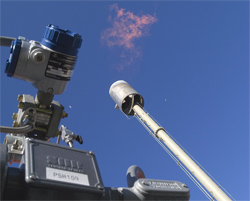UNH's EcoLine™ Project Honored by EPA

Credit: Mike Ross, UNH Photographic Services.
DURHAM, N.H. - The U.S. Environmental Protection Agency (EPA) has named the University of New Hampshire's EcoLine™ as a Project of the Year, the agency announced last week. EcoLine™ is a landfill gas-to-energy project that uses purified methane gas from a Waste Management landfill in Rochester to provide up to 85 percent of campus power. When EcoLine™ started in May 2009, UNH became the first university in the nation to use landfill gas as its primary fuel source.
"We are proud to recognize UNH's EcoLine, a Landfill Methane Outreach Program partner which is turning trash into a clean and profitable source of energy," said Gina McCarthy, assistant administrator for the EPA's Office of Air and Radiation. "This project, and others like it, is helping us transition into a clean energy economy and make important greenhouse gas reductions."
"It's a great honor to receive this award from the EPA," says UNH assistant vice president for energy and campus development Paul Chamberlin, who accepted the award Jan. 12, 2010 at the EPA's Landfill Methane Outreach Program's (LMOP) annual conference in Baltimore. "I share the recognition with the many team members here at UNH and at Waste Management who helped bring this complex project to successful fruition."
EcoLine™ is a partnership with Waste Management's Turnkey Recycling and Environmental Enterprise (TREE) in Rochester, where the naturally occurring by-product of landfill decomposition is collected via a state-of-the-art collection system consisting of more than 300 extraction wells and miles of collection pipes.
After the gas is purified and compressed at a UNH processing plant at TREE, it travels through a 12.7-mile-pipeline from the landfill to UNH's cogeneration plant, where it replaces commercial natural gas as the primary fuel source. In operation since 2006, UNH's cogeneration plant captures waste heat normally lost during the production of electricity and uses this energy to heat campus buildings. UNH is selling the renewable energy certificates (RECs) generated by using landfill gas through 2015 to help finance the overall cost of the project and to invest in additional energy efficiency projects on campus.
Also receiving Project of the Year recognition from LMOP were Jefferson City, Missouri's Renewable Energy Project, Jefferson City, Mo.; The Altamont Landfill Resource and Recovery Facility, Livermore, Calif.; Ox Mountain LFG Energy Project, Half Moon Bay, Calif.; Sioux Falls Landfill & Poet LFG Pipeline, Sioux Falls, S.D. and the Winder Renewable Methane Project, Winder, Ga. The State Partner of the Year was given to the Kansas Department of Health and Environment, and the Community Partner of the Year was awarded to the Kent County Department of Public Works, Byron Center, Mich.
The University of New Hampshire, founded in 1866, is a world-class public research university with the feel of a New England liberal arts college. A land, sea, and space-grant university, UNH is the state's flagship public institution, enrolling 12,200 undergraduate and 2,200 graduate students.
-30-
Photographs available to download:
/unhtoday/news/cj_nr/2009/feb/lfgflarebig.JPG
The University of New Hampshire's EcoLine™ is a ground-breaking landfill gas-to-energy project that will use purified methane gas from a Waste Management landfill as the campus's main energy source.
Credit: Mike Ross, UNH Photographic Services.
/unhtoday/sites/default/files/newsroom/img/pipeline/_L071537.jpg
/unhtoday/sites/default/files/newsroom/img/pipeline/_PAS4632.jpg
A 12.7-mile pipeline brings purified landfill gas from Waste Management's Turnkey Recycling and Environmental Enterprise (TREE) facility in Rochester to the University of New Hampshire campus in Durham, where it will provide up to 85 percent of the university's energy needs.
Credit: Perry Smith, UNH Photographic Services.
Latest News
-
December 4, 2025
-
November 26, 2025
-
November 6, 2025
-
November 5, 2025
-
October 24, 2025














































